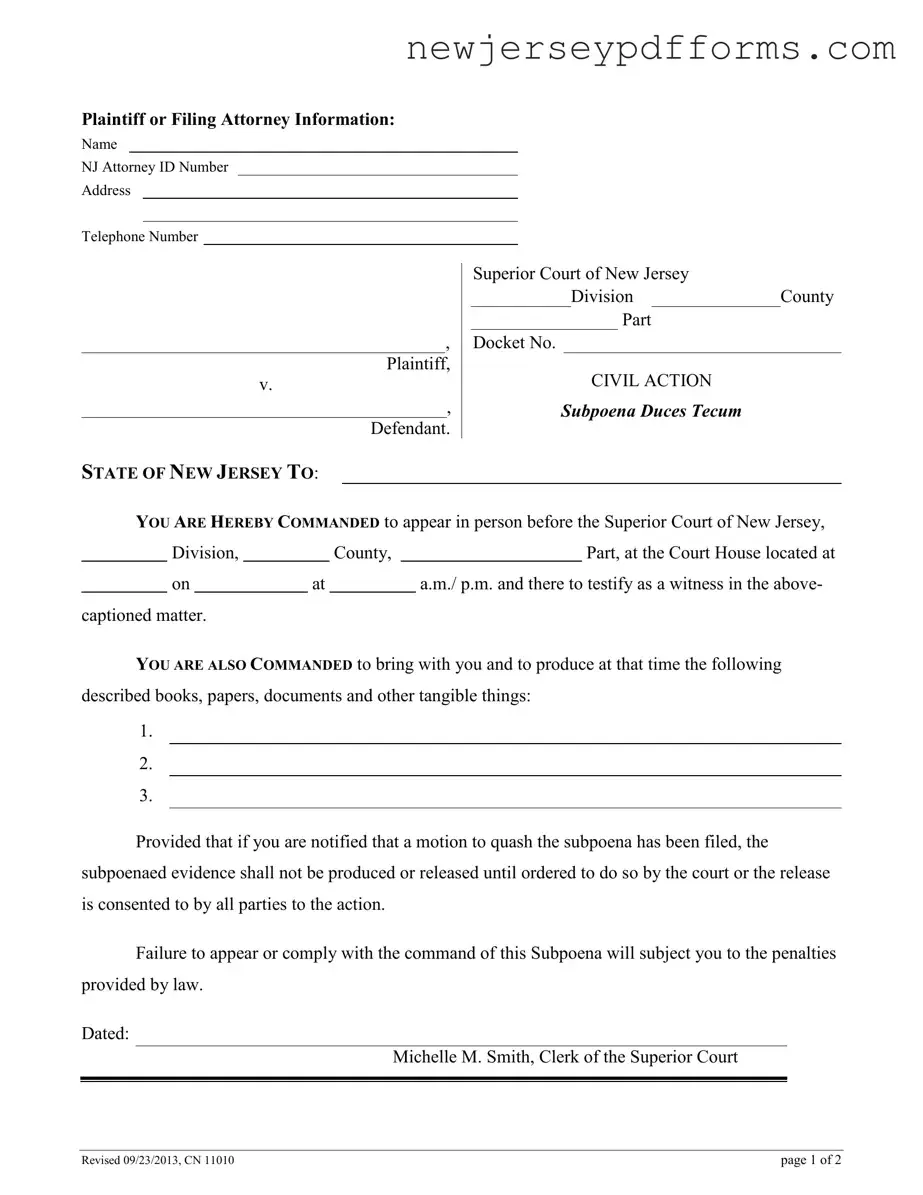The New Jersey Subpoena form is similar to a summons. A summons is a legal document that notifies a defendant that a lawsuit has been filed against them. It compels the defendant to respond to the complaint within a specific timeframe. Like a subpoena, a summons serves as a formal command, but it focuses on requiring a response rather than attendance or the production of documents. Both documents are essential in ensuring that parties involved in legal actions are properly informed of their obligations.
Another document akin to the New Jersey Subpoena is a notice to produce. This document requests a party to provide specific documents or evidence relevant to a case. While a subpoena can be issued to third parties, a notice to produce is typically directed at the opposing party in the litigation. Both documents require compliance, but a notice to produce often arises during the discovery phase of litigation, whereas a subpoena can be issued at any stage.
A deposition notice is also similar to the New Jersey Subpoena form. This document informs a witness that they are required to provide testimony under oath, usually in a lawyer's office rather than in court. Like a subpoena, a deposition notice mandates attendance, but it specifically pertains to oral testimony rather than the production of documents. Both serve to gather information essential for the case.
The request for admissions is another related document. This legal tool allows one party to ask another to admit or deny specific facts related to the case. While it does not command attendance or document production, it seeks to streamline the litigation process by establishing certain facts as undisputed. Both requests for admissions and subpoenas aim to clarify issues before the court, albeit in different ways.
Understanding the nuances of various legal documents is essential, particularly in the context of their functions and implications. For example, the Release of Liability form not only protects against claims arising from accidents but also serves as a reminder of the risks involved in many activities. This type of document can often be compared to other legal constructs, such as a PDF Document Service template that guides users through the necessary steps in crafting a comprehensive release form, highlighting the importance of proper documentation in safeguarding one's interests.
In addition, an interrogatory is similar to the New Jersey Subpoena form. Interrogatories are written questions that one party sends to another, requiring them to respond in writing and under oath. This document helps gather information, much like a subpoena, but focuses on written responses instead of live testimony or document production. Both tools are part of the discovery process and help build a case.
A court order for production of documents shares similarities with the subpoena. This order is issued by a judge and compels a party to produce specific documents for inspection. While a subpoena can be issued by an attorney, a court order carries the weight of judicial authority. Both documents aim to ensure that relevant evidence is made available for legal proceedings.
Another related document is a writ of attachment. This legal order allows a party to seize a defendant's property to secure a judgment. While a writ of attachment does not require testimony or document production, it serves a similar purpose in enforcing a party's rights within the legal system. Both documents are tools to ensure compliance with legal obligations.
Additionally, a motion to compel is comparable to the New Jersey Subpoena form. This document is filed by one party to request the court to order another party to comply with a discovery request, such as answering interrogatories or producing documents. While a subpoena directly commands compliance, a motion to compel seeks judicial intervention to enforce compliance. Both are essential in the discovery process.
Lastly, a protective order is similar in that it seeks to safeguard a party's interests during the discovery process. This document can limit the scope of discovery or protect sensitive information from being disclosed. While it does not command attendance or document production, it addresses concerns related to the compliance of subpoenas and other discovery requests. Both documents play crucial roles in managing the flow of information in legal proceedings.
